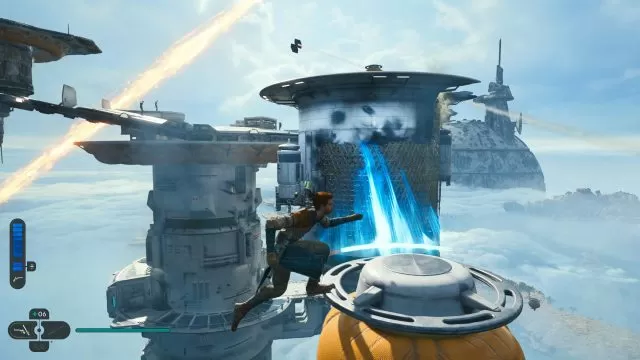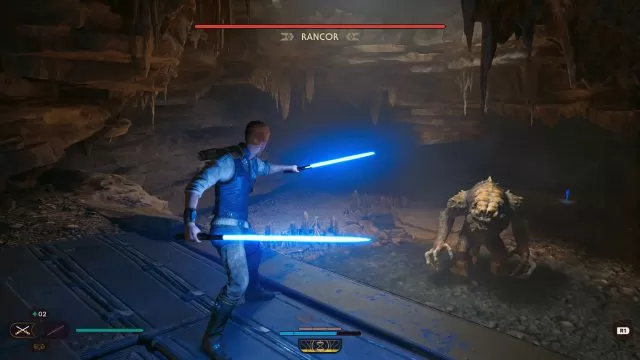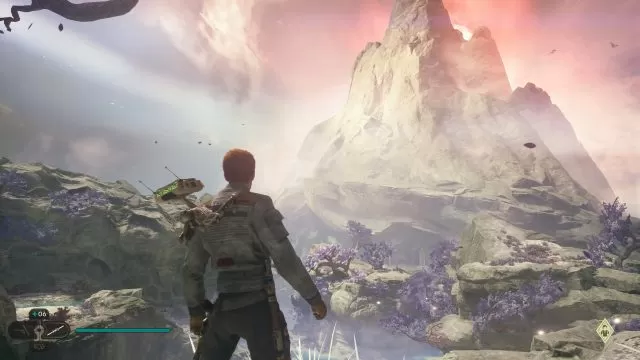Star Wars: Jedi Survivor Review – Prince of Persia
It’s a well-known fact that Jedi are noble, nimble, and sometimes conflicted. Star Wars movies, TV shows, and books established those facts a long time ago, codifying this unique Sci-Fi warrior monk archetype. Translating those virtues and a potential weakness into the gaming environment is a very daunting prospect because there’s little room to maneuver. Jedi are predictable. They have few default and well-documented temptations and even fewer responses to conflicting stimuli. No Jedi is even remotely exciting unless his faith is severely tested. Any alcoholic bounty hunter offers a more intriguing framework for a half-decent Star Wars story.
So how do you make a Jedi-centered game interesting, apart from making everything about lightsaber combat? The Jedi Knight series died twenty years ago because no one had a clear answer to that question. The Interactive Jedi concept briefly succeeded in Knights of the Old Republic, a game that compensated for the boring Jedi archetype with a fantastic plot and plenty of characters who used Jedi as a mirror to reflect themselves in. But that was it for the next decade and a half, until Star Wars: Fallen Order came out.
Fallen Order had the novelty factor, rich environments, and soulsborne lite combat working strongly in its favor, and the game never outstayed its welcome. It worked because it gave us a story of a mentorless, runaway padawan working his way to Jedihood outside established patterns. Everyone loves a successful underdog origin story. Oliver Twist who doesn’t beg for more food, but cuts his oppressors with a sword made of light.
Putting the band back together

So how do you improve upon that? Respawn and EA decided to simply continue Cal’s struggle against Empire, putting our hero on the flat narrative plane. Instead of growing upwards, he’s about to have his wins and will challenged in a new adventure, a bit more generic than the previous one. This is an interregnum story, before the final, third game which will ultimately test his resistance to the Dark Side of the force. It’s unannounced yet, but it’s predictable as Armaggedon.
Five years after the events of the first game, the Mantis crew scattered to the four galactic winds. Cal works for Saw Gererra now, randomly hitting the Galactic Empire where it hurts, hoping to achieve some permanent impact. After the disastrous mission on Coruscant and the narrow escape, Cal makes an emergency landing on Koboh. Greez, his former shipmate, part-time cook, and full-time pilot, owns a cantina there, entirely unaware that the planet hides a major secret from the High Republic era.
Inside the nebula enveloping the Koboh system lays Tanalorr, a hidden world strong in the force. Two hundred years ago, it was chosen as the site for a Jedi temple, was contested, and set to be abandoned. One headstrong Jedi master, however, refused to obey the council and fought to remain in control of it. Cal recognizes Tanalorr as a potential sanctuary for everyone fleeing the Imperial oppression, but the ghosts of the past will mess up that plan. There’s an additional problem. The nebula is deadly, and navigating it requires long-lost High-Republic compass gadgets. Cal will assemble the crew anew and embark on the perilous wild goose chase on several planets, moons, and space stations.
Identity crisis

The developers avoided the lame prospect of ability reset, leaving Cal powerful and deadly from the start. This instantly presented a significant conceptual challenge, which led to the core of Jedi Survival’s problem. How to solve combat omnipotency? Respawn chose to focus on the nimble part of the Jedi archetype, making the game 80% about navigating the environment and parkour acrobatics. You mastered the combat, now conquer the terrain! Not everyone will be thrilled about the prospect.
Star Wars: Jedi Survivor is a 3D puzzle platformer masquerading as a casual souls-like exploration/action adventure. You need to know that fact before you decide to spend seventy bucks on it. Most of my esteemed colleagues from other gaming media are focusing on the shabbiness of the PC version when they talk about the CONS of the Jedi Survivor experience, but I guess that its core identity is a much bigger issue.
For most of the early and mid-game, the ratio between parkour and everything else, including combat, is 70% to 30%. You will ENDLESSLY jump, run along walls, latch onto platforms, slide downwards, hang from zip lines, perform forward dashes, and whatnot. Every once in a while, the game will introduce a new move, and it will proceed to mercilessly shove it into your throat for the remainder of the mission. I can’t stress this enough – you’ll play Tarzan on steroids for hours at a time. Planets are vast and designed in a 3D Metroidvania manner, which means every newly acquired ability facilitates revisiting the zones with previously insurmountable obstacles.
Improved combat

Star Wars: Jedi Survivor is the best when it stops treating you like a monkey and decides that you can be a simple, grounded Jedi again. Combat is superb and significantly more kinetic than before, with greater emphasis on parrying and lightsaber stances. If Fallen Order felt like Dark Souls 3, Jedi Survivor definitely carries a strong Bloodborne vibe. The parrying timings are tighter, blocking is limited by stamina and its efficiency varies depending on your foe. Rancor, for example, facilitates avoidance, not blocking.
There are two new lightsaber stances, blaster and crossguard. The first one uses a blaster in one hand, with lightsaber attacks as means of replenishing ammunition. The second one is all about slow and powerful attacks. You can have two stances equipped simultaneously, and changing requires visiting a meditating circle. Personally, I found the double-bladed stance universally good in all circumstances.
The last third of the game is the best part. Besides the significant and semi-unexpected revelations, the game eases up on parkour and focuses almost solely on combat. Most of the challenging fights are reserved for the near-finale, as the majority of combat challenges up to this point were relatively simple. After the ending credits, you can either continue exploring, or you can start a new Game Plus mode with a couple of fresh perks and unique mutators.
Waiting for Episode III

If you are a total completionist, the game could offer you up to fifty hours of content. There are numerous data discs, minerals, scrolls, and other gizmos to find and trade for various items with several vendors. The cantina on Koboh serves as a hub for all the people you met and saved during your adventure. Some of them might offer you a side quest in the form of a rumor you could go exploring. You can liven up the cantina by unlocking different music tracks, planting various plants on the rooftop garden, etc, if you crave to suck the last molecule of content from your purchase.
We can say a lot of things about Star Wars: Jedi Survivor, but most people will agree that the first game was better designed and had a more significant cultural impact. Let’s hope Jedi Survivor is that filler mid-chapter before the thunderous finale, whenever it may come.
Highs
- Way better combat compared to the previous game.
- Significantly more open than Fallen Order.
- Rich in optional content.
Lows
- Cal Kestis is remarkably dull.
- Too much parkour and navigational acrobatic.
- Average story devoid of exciting and impactful villains.

